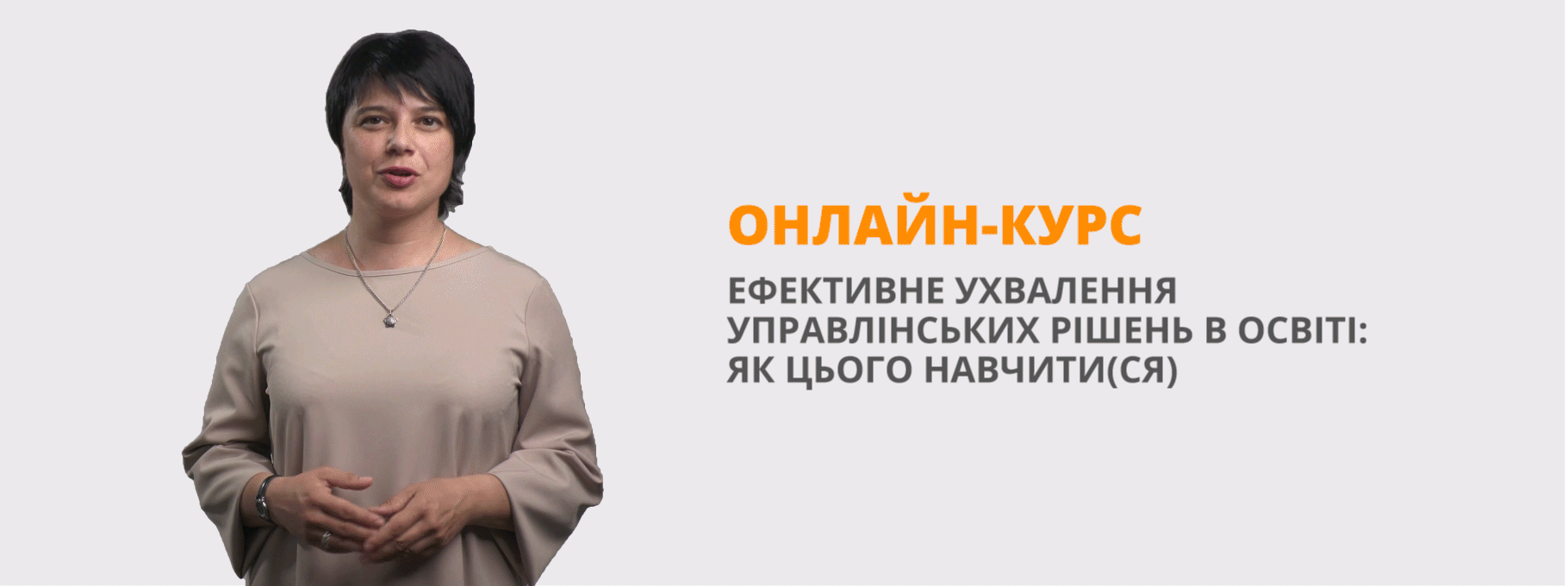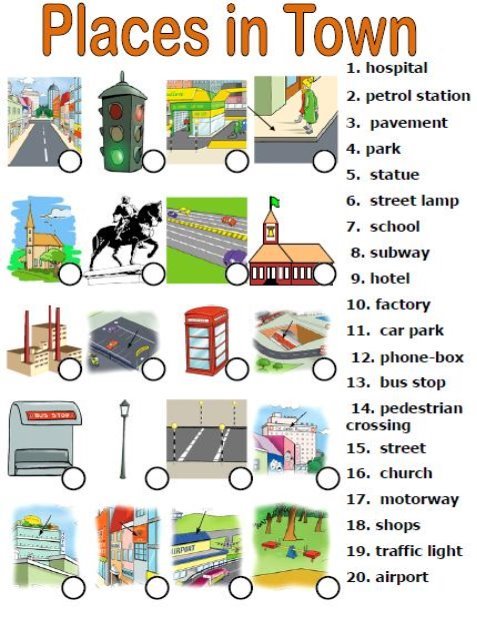Урок " The Place I Live in, the Place I Love the Most!”
Lesson Plan
“My Town. The place I Live in, the Place I love the Most”
Key info
|
45 minutes |
||
|
|
||
|
Getting about the town Audio |
||
|
|
||
|
Equipment: |
A computer, an interactive board, the presentation “ The Place I Live in, the Place I Love the Most” |
Lesson procedure
Warm-up
T .Good morning, children! Nice to see you again! It’s time to begin our lesson.
How are you? Is anybody absent? Why?
So let’s start our work. Look at the blackboard. You can see some words there. Put them in the right order and say the famous English saying that will help you to guess what we are going to speak about today. (slide 1)
Pupils guess lesson content and the teacher explains lesson objectives and gives other instructions.
On the blackboard: or, home, East, is, West, best. (East or West, home is best). (slide 2)
T. Well, today we'll speak about our native town, the place we live in, the place we love the most. For starters, I want everybody to do a shot Questionnaire.
( Student’s worksheet - task 1)
|
What country are you from? a. Italy; b. Spain; c. Ukraine; 2. Where do you live? a. In a big city; b. In a small city; c. In a village. 3. What description is appropriate to your city / town / village? a. Country town; b. Manufacturing/industrial; c. Historical. 4. Do you think your city/town offers opportunities of living and working? a. Yes, the place I’m living in gives opportunities of living and working; b. No, the place has not many opportunities of living and working; 5. Do you think your city/town offers opportunities of studying? a. Yes, the place I’m living in gives me opportunities of studying; b. No, the place I’m living in has not many opportunities of studying.
|
T: Well, today I want us to make our own story about our home town.
Practice & Production
T: For starters, let us see how much you know about our home town?
The teacher asks students questions about the home town and gives them some extra information.
T. Where do we live?
S. ( We live in Rubizhne in Ukraine.)
T. Is it a town or a city?
S (Rubizhne is a mid-sized city.)
T. Where is it situated? (slide 3)
S. (In Luhansk region in the South–East of Ukraine.)
T. How many people live here?
- (There are about 65,000 people living in Rubizhne today.)
T. These are the flag and the coat of arms of Rubizhne. (slide 4)
Do you know where the name of our town comes from?
S. It comes from the word “rubizh” that means “boundary”. Cossacks , who defended the boundaries of their native land, lived here.
T. When was our town founded?
S. The settlement appeared here in the 18th century.
T. Right, but the town really started life with the building of a railway line between Licichansk and Kupiaynsk in 1894. Between 1915 and 1917, a settlement called Rusko-kraska was built nearby to support the Rusko-kraska chemical plant and this was really the beginning of the town. By 1934 the town had grown enough to receive a city status.
T. Well, I see you know and you can tell a lot about our home town.
Before to start making our story about our town I want us to revise the vocabulary we need to describe a town.
Let’s do task 2 in your worksheets.
Pupils find adjectives used for describing a city on word cloud, do task 2 in writing and make up the opening remarks for the story about their home town.
Task 2 Find the adjectives you need to describe a town/city.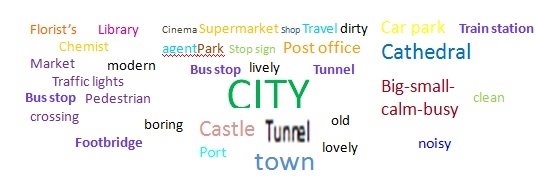
Pair the adjectives and write them in the right place.
Key: (Big-small, calm-busy, old-modern, dirty-clean, lovely-ugly, lively-boring)
_____________________________________________________________
|
POSITIVE |
NEGATIVE |
|
|
|
|
|
|
|
|
|
|
|
|
|
|
|
|
|
|
Write. WHAT’S YOUR CITY LIKE? ____________________IS_________________________________________
T. Now Let’s brush up Our Town vocabulary.
Do task 3 in your worksheets. Match the words with the places in town. Change your papers and check how well your partner knows the words.
Task 3 Match the words with the places in town.
|
|
T. Our next step is a guessing game. Tell me what places in the town these are?
The students answer the teacher’s questions.
- You can see movies there (cinema).
– You can see doctors there (hospital).
– You can see animals there (zoo).
– You can see old things there (museum).
– You can change money there (bank).
– You can do sports there (sport centre).
– You have lessons there (school).
– Tourists can live there (hotel).
- You can buy magazines and newspapers there (newsagent’s)
- You can post a letter or buy stamps there (post office)
- You can borrow books there (library)
- You can get a haircut there (hairdresser’s)
- You can book a holiday the (travel agent’s)
- You can get medicine there (chemist’s)
- You can buy fruit and vegetables there (market)
- You can buy flowers there (florist’s)
T. Well done, you know the places in town very well. But there is one more important thing we need to do well with in order to be able to describe our town. I mean the propositions of place. Look at Task 4 in your Worksheets. Listen to two people talking and draw the route on the map. Pupils do task 4.
Task 4 Listen to two people talking and draw the route on the map
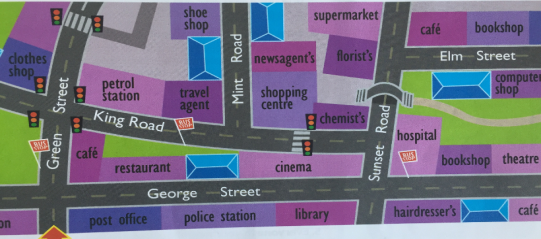
T. Task 5. Now imagine, you are in one of the streets of Rubizhne and you need to get to some places in the town. So try to do it. Read and circle the right proposition. Pupils do task 5.
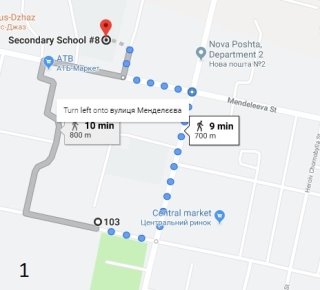
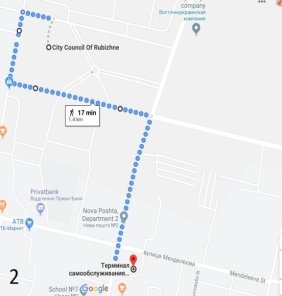
|
Imagine, you are in one of the streets of Rubizhne. Read and choose the right proposition. A: Excuse me, is there a florist’s near here? B: Yes, there’s one in Bohdan Khmelnitsky Street. It’s opposite / next to a Palace of sport. A: How do I get there? B: Well, we’re in Mendeleev Street now. Go straight on and on / at the traffic lights turn right. Go past / through the Central Market and turn right at the crossroads. That’s Bohdan Khmelnitsky Street. Go along / around this street and the florist’s is on your left. A: Thank you very much. 2. A: How do I get from / at the bus station to the City Hall? B: Well, go along/into Vyzvolyteliv Street and turn left to/into Myra Street. Go straight on.The Town Hall is on your right, behind/opposite the Palace of Culture |
T. Now it’s time to introduce your project works. You were asked to take photos of the places in our town you consider to be worth telling about. I have chosen some of them. I believe they will illustrate our story and make it really interesting.
Photo1. (slide 5)
T. In this photo you can see Rubizhne Cardboard and Paper works. Now let’s do task 6. You should put the words in the sentences in the right order to get the story about job opportunities in our town. Pupils do task 6.
Task 6 Put the words in the sentences in the right order.
|
1. of Ukraine/ Rubizhne/ industrial centers/one /is/of the important /industrial centers/ in the East. 2. are /many/ There/ plants /and/ / factories/ here. 3. plant “Zorya”/ the Rubizhne Cardboard and / plastic goods /produce different chemicals products/ Paper Works and other enterprises/explosives /medicines etc/ The chemical/ cardboard and paper/plastic goods/. |
Key: 1.Rubizhne is one of the important industrial centers in the East of Ukraine.
2.There are many plants and factories here.
3. The chemical plant “Zorya”, the Rubizhne Cardboard and Paper Works and other enterprises produce different chemicals products, explosives, cardboard and paper, plastic goods, medicines, etc.
Photo2. (slide 6)
T. One more photo and one more challenge for you. You should complete the text with the words in the box to get the next part of the story. Pupils do task 7.
Task 7 Complete the text with the words in the box.
|
churches wide history famous modern restaurants full |
|
My town is quite _____ and busy. The streets are ____and clean. They are ___of people. There are many shops, cafes and _______here. If you want to see the places of interest in our town, you should walk around it and see some beautiful ____, the monuments to_______ people and visit a town museum to get to know more about the history of our town. |
Key: My town is quite modern and busy. The streets are wide and clean. They are full of people. There are many shops, cafes and restaurants here. If you want to see the places of interest in our town, you should walk around it and see some beautiful churches, the monuments to famous people and visit a town museum to get to know more about the history of our town.
Photo3. (slide 7)
T. The city of Rubizhne has also become home of many educational establishments. Now I want you to do matching. Match the parts of the sentences in order to get a description of good opportunities of getting education in our town.
Pupils do task 8.
Task 8 Match the parts of the sentences.
|
1. Rubizhne is a) Ukraine and abroad study there. 2. Many educational b) a students town 3.There are ten schools, a lyceum, a school of arts, three technical colleges,. the Institute of chemical technologies c) establishments are located here. 4.Many young people from d) of the East Ukrainian State university and Luhansk Medical university in our town. |
Key: 1.b, 2.c, 3.d, 4.a
Photo 4. (slide 8)
T. There are several residential areas in our town, which are connected by transport routes. To get a story about the city transport I want you to fill each gap in the text with one word. Pupils do task 9.
Task 9 Fill in the gaps with one word.
|
The roads in my town are very good. They are full of ____ and ____. There are no traffic ___in my town and many people use ______ transport. You may use ___ service as well. As the distances in my town are not long, there is one more popular way of getting about the town. It is a _____. There is also a _____ station in Rubizhne. |
Key. The roads in my town are very good. They are full of cars and buses. There are no traffic jams in my town and many people use public transport. You may use taxi service as well. As the distances in my town are not long, there is one more popular way of getting about the town. It is a bicycle. There is also a railway station in Rubizhne.
Photo 5. (slide 9)
T. In this photo you can see the Children’s Park in the southern district of our town. It is Lisa’s Project work. She took this photo and She took this photo and prepared a story about it because it is her favorite place in our town.
S. The Children Park is one of the favorite places both of children and grown-ups In the spring of this park is full of beautiful greenery and in summer you can watch the roses bloom. There are some great rides and playgrounds where you can have fun slide to slide swing on the swings and you can still ride a real pony or a horse. There are also bright trampolines which I adore. On a hot summer day you can enjoy the murmur of the fountain which is located in the center of the park among the tall chestnut trees.
Wrap Up
T. In order to sum up the results of the discussion and check what the pupils have memorized about the town they live in the teacher asks them to fill in the File about Rubizhne. (slide 10) Pupils do task 9.
Task 10 Fill in the File about Rubizhne.
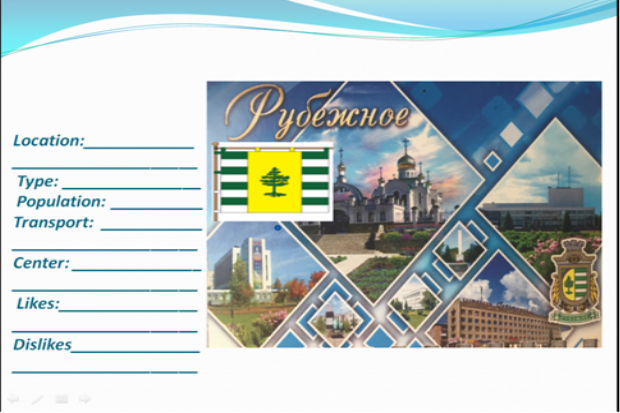
Follow up/Homework
T. Finally, the time comes! Our lesson will be over in a few minutes. Thank you for your active participation in the discussion. I believe we did well and made up an interesting story about our home town. I hope that you enjoyed our today’s meeting as much as I did. But the final straw today will be your home task. I want you to prepare stories about your favorite places in the town illustrating the stories with a photo or a short video. Last but not the least, I want to show you an amazing film about our town.

про публікацію авторської розробки
Додати розробку
